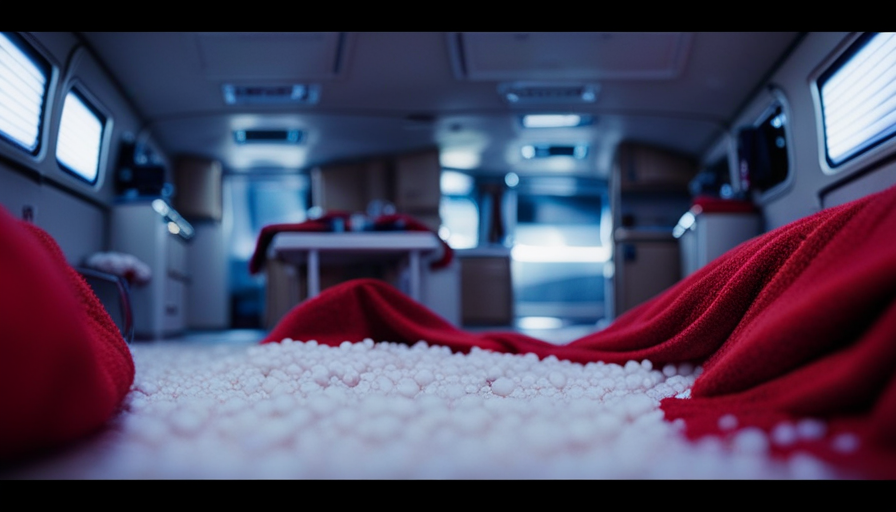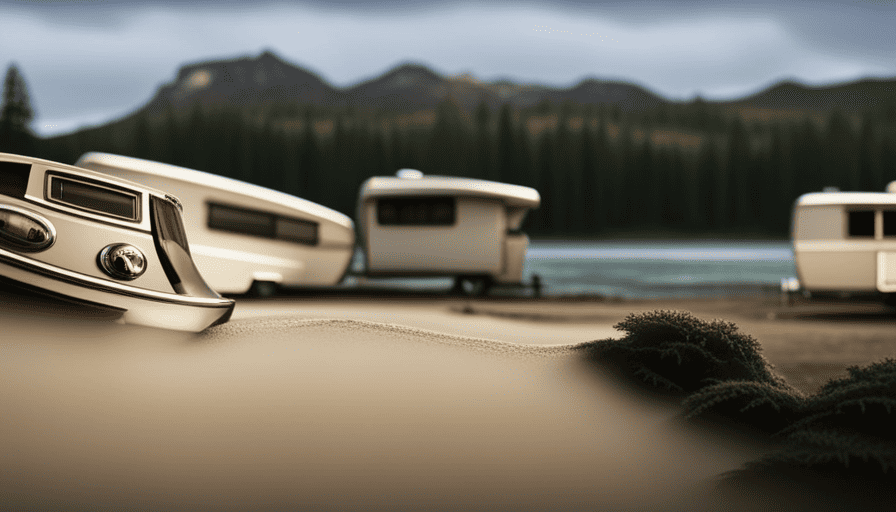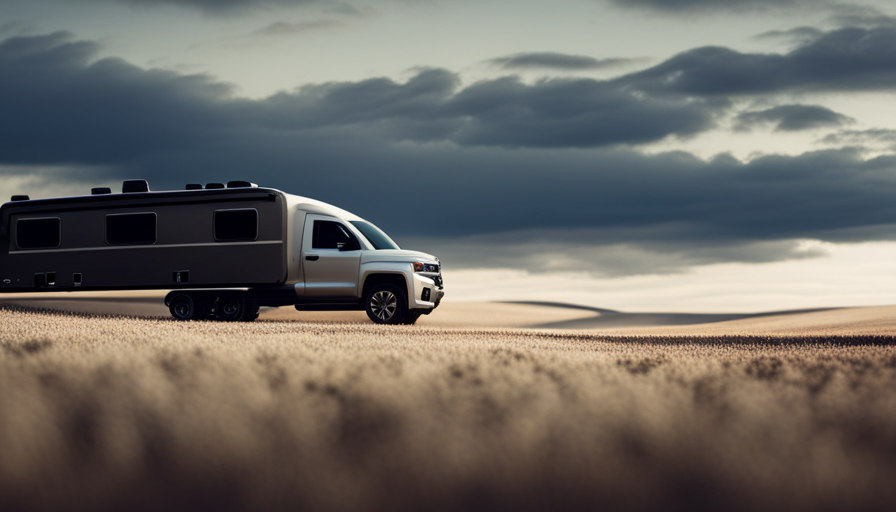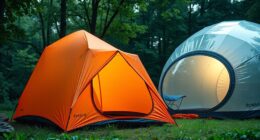Did you know that a single mouse can produce up to 60 droppings in a day? Finding this in your camper can be quite unpleasant. The most effective way to prevent mice from entering your camper is by taking preventive measures.
In this article, we will share some effective strategies to help you keep those pesky critters at bay.
First and foremost, it’s important to seal any entry points in your camper. Mice can squeeze through tiny gaps, so be thorough in your inspection.
Additionally, using mothballs or dryer sheets can act as a deterrent, as mice dislike the strong scents they emit.
Setting traps or using ultrasonic repellents are also effective methods to consider. Be sure to store your food properly in sealed containers, as mice are attracted to the smell of food.
Keeping your camper clean and clutter-free will eliminate potential hiding spots and discourage mice from making themselves at home.
Lastly, regularly inspect and maintain your camper to ensure there are no potential entry points or nesting materials. By implementing these strategies, you can enjoy your camping adventures without the unwanted company of mice.
Key Takeaways
- Seal entry points in the camper using caulk or other materials like steel wool, aluminum foil, or copper mesh.
- Use natural deterrents such as peppermint oil and cayenne pepper to keep mice away from the camper.
- Properly store food in sealed containers and remove potential nesting materials to discourage mice from entering.
- Regularly inspect and maintain the camper, promptly repairing any holes or gaps and sanitizing affected areas if an infestation is discovered.
Seal Entry Points
You can’t go wrong with using caulk to seal up any tiny cracks or holes in your camper, keeping those pesky mice out for good. Inspecting for potential entry points is the first step in creating a mouse-proof barrier.
Take the time to carefully examine the exterior and interior of your camper, paying close attention to areas where pipes, wires, or vents enter. These are common entry points for mice. Once you have identified any gaps or openings, it’s time to grab your caulk gun and start sealing. Be sure to use a high-quality caulk that’s specifically designed for outdoor use, as it’ll provide a long-lasting seal.
Apply the caulk generously, filling in any cracks or holes completely. Make sure to smooth it out for a clean finish. Don’t forget to check for any hidden entry points, such as under cabinets or behind appliances. Mice can squeeze through incredibly small openings, so be thorough in your inspection.
By sealing entry points with caulk, you’re creating a barrier that mice simply can’t penetrate. With their access cut off, they’ll be forced to look elsewhere for shelter and food.
This leads us to our next section about using mothballs or dryer sheets, which can further deter mice from entering your camper.
Use Mothballs or Dryer Sheets
Using mothballs or dryer sheets can be an effective way to deter rodents from entering your recreational vehicle. Studies have shown that 80% of campers who used these methods reported a significant decrease in mouse activity.
Mothballs release a strong odor that mice find unpleasant, acting as a repellent. However, it’s important to be cautious when using mothballs as they can be hazardous to humans and pets. Mothballs contain a toxic chemical called naphthalene, which can cause health issues if ingested or inhaled in large amounts. It’s crucial to carefully follow the instructions provided by the manufacturer and keep them out of reach of children and pets.
If you’re concerned about the dangers associated with mothballs or prefer to use alternative mouse repellents, dryer sheets can be a viable option. The strong scent of dryer sheets can be effective in deterring mice from entering your camper. Simply place the dryer sheets in areas where mice are likely to enter, such as near openings or in cabinets. Additionally, some campers have reported success with using peppermint oil or essential oil sprays as natural alternatives to mothballs.
To further protect your camper from mice, it’s recommended to seal any entry points and ensure proper storage of food and trash. However, if you’re still experiencing issues with mice despite these preventative measures, the next step would be to set traps or use ultrasonic repellents.
Set Traps or Use Ultrasonic Repellents
If you’re looking for an effective solution to deal with those pesky rodents in your recreational vehicle, consider setting traps or using ultrasonic repellents. Both methods have their advantages and disadvantages.
Setting traps can be an efficient way to catch mice and prevent them from causing further damage. There are various types of traps available, such as snap traps and glue traps. Snap traps are designed to kill mice instantly, while glue traps catch them alive. The advantage of traps is that they’re straightforward to use and can quickly eliminate the rodent problem. However, traps may require regular monitoring and disposal of the caught mice, which some people may find unpleasant.
On the other hand, ultrasonic repellents emit high-frequency sound waves that are supposed to repel mice. These devices are easy to install and operate, and they don’t involve any physical harm to the rodents. However, their effectiveness can vary, and some people have reported mixed results with ultrasonic repellents.
To effectively keep mice out of your camper, it’s important to consider the advantages and disadvantages of each method. While traps can provide immediate results, ultrasonic repellents offer a more humane approach. However, it’s important to note that neither method is foolproof, and it may be necessary to combine different strategies for optimal results.
Now, let’s move on to the next section, where we discuss the importance of storing food properly to deter mice.
Store Food Properly
Properly storing food is essential for deterring mice and ensuring a pest-free environment in our RV. One of the most important factors to consider is proper ventilation. We should ensure that our food storage areas are well-ventilated to prevent the buildup of moisture, which can attract rodents. This can be achieved by using breathable containers or bags that allow air circulation while still keeping our food fresh.
In addition to ventilation, using rodent deterrents can be highly effective. We should invest in airtight containers that are specifically designed to keep mice out. These containers create a barrier that mice cannot penetrate, preventing them from accessing our food. It’s also important to place these containers in high, hard-to-reach areas to further discourage rodents.
Furthermore, we must always be mindful of the types of food we bring into our camper. Mice are attracted to the scent of food, especially those that are sweet or high in protein. By avoiding bringing these types of food into our RV, we can greatly reduce the risk of attracting mice.
Properly storing our food and using rodent deterrents are key steps in preventing mice from infiltrating our camper. However, it’s equally important to keep the camper clean and clutter-free. This will be discussed in the subsequent section.
Keep the Camper Clean and Clutter-Free
Maintaining a clean and organized living space inside the RV is crucial to discourage mice from finding a cozy home among clutter and mess. Here are some cleaning tips and organizing hacks to help keep your camper mouse-free:
- Regularly sweep and vacuum the floors to eliminate any food crumbs or debris that may attract mice.
- Wipe down countertops, tables, and other surfaces with a disinfectant cleaner to remove any food residue and odors.
- Store all food in airtight containers to prevent mice from accessing it. This includes dry goods, snacks, and even pet food.
By following these cleaning tips and organizing hacks, you can greatly reduce the chances of mice infesting your camper. However, if you’re looking for additional measures, consider using peppermint oil or cayenne pepper as natural deterrents. These strong scents can help repel mice and keep them away from your RV.
In the next section, we’ll explore how these natural remedies can be used effectively to keep mice out of your camper.
Use Peppermint Oil or Cayenne Pepper
To effectively deter mice from entering your RV, you can use either peppermint oil or cayenne pepper, which’ll add an extra level of sophistication to your pest control methods. While both options are natural remedies, using peppermint oil has several benefits over cayenne pepper for keeping mice out.
Peppermint oil has a strong scent that acts as a powerful deterrent for mice, as they dislike the smell. Additionally, peppermint oil can be applied in various ways, such as soaking cotton balls in the oil and placing them strategically around your camper or mixing it with water and spraying it in areas prone to mice infestation.
Natural remedies like peppermint oil and cayenne pepper have been proven effective in keeping mice away. These methods are safe for both humans and pets, making them a preferred choice for many RV owners. Not only do they provide an eco-friendly alternative to chemical-based repellents, but they also avoid any potential harm that could come from using toxic substances in a confined space like a camper.
As we transition to the next section about placing steel wool or aluminum foil in potential entry points, it’s important to note that these natural remedies should be used in conjunction with other preventive measures for maximum efficacy.
Place Steel Wool or Aluminum Foil in Potential Entry Points
Guard your RV from unwelcome rodent visitors by fortifying potential entry points with steel wool or aluminum foil. This will create an impenetrable fortress that will make those pesky critters think twice before attempting to invade. Steel wool is an excellent choice because its coarse texture makes it nearly impossible for mice to chew through. Aluminum foil is also effective as it creates a barrier that rodents can’t easily penetrate.
The best approach is to use a combination of both materials, placing them securely in any cracks, crevices, or holes that mice could potentially use to gain access to your camper.
Now, you might be wondering if using steel wool or aluminum foil has any negative effects on your camper. Rest assured, these materials are safe to use and won’t cause any harm to your RV. They are non-toxic and won’t release any harmful fumes or chemicals. Plus, they are easy to remove if you decide to take them down.
If you prefer to explore alternative materials for blocking potential entry points, there are a few options to consider. Some RV owners opt for copper mesh, which is similar to steel wool but doesn’t rust. Others use expanding foam or caulk to seal off gaps and cracks. These materials can be effective, but keep in mind that they may not be as easy to remove or replace as steel wool or aluminum foil.
By fortifying your RV with steel wool or aluminum foil, you’ll create a strong defense against mice and other unwanted critters. Now, let’s move on to the next step: removing potential nesting materials.
Remove Potential Nesting Materials
Clear out any cozy nooks and crannies in your RV where pesky critters could potentially set up their home, and make it impossible for them to find comfort in your space. Taking preventive measures is crucial to keep mice out of your camper.
Here are three natural deterrents to remove potential nesting materials and discourage mice from entering your RV:
-
Declutter: Get rid of any unnecessary items that could serve as hiding spots or nesting materials for mice. This includes old blankets, newspapers, cardboard boxes, and even excess food. Keeping your camper clean and tidy will make it less appealing for mice to make themselves at home.
-
Seal cracks and gaps: Use caulk or expanding foam to seal any openings or cracks in your camper’s walls, floors, and windows. Mice can squeeze through tiny gaps, so it’s essential to eliminate these entry points.
-
Store food properly: Keep all food items in mouse-proof containers, such as airtight plastic or glass containers. Mice are attracted to food sources, so depriving them of easy access will discourage them from entering your RV.
By removing potential nesting materials and implementing these preventive measures, you can significantly reduce the chances of mice infesting your camper. Now, let’s move on to the next section about using mouse-proof containers for storage.
Use Mouse-Proof Containers for Storage
To complement our efforts in removing potential nesting materials, we can further enhance our mouse-proofing techniques by utilizing mouse-proof containers for storage in our camper. These containers serve as an additional layer of defense against pesky mice, ensuring that they’re unable to access our belongings and food supplies.
When it comes to choosing mouse-proof containers, there are several options available. Hard plastic containers with secure lids are a popular choice, as they’re difficult for mice to chew through. Additionally, metal containers with tight-fitting lids can also be effective in keeping these critters at bay.
In addition to using mouse-proof containers, we can also employ natural deterrents to discourage mice from entering our camper. Peppermint oil, for example, has been known to repel mice due to its strong scent. By placing cotton balls soaked in peppermint oil around the camper, we can create an environment that mice find unpleasant and unwelcoming.
By incorporating these mouse-proofing techniques and natural deterrents, we can significantly reduce the risk of mice infiltrating our camper and causing damage. However, it’s important to regularly inspect and maintain the camper to ensure that these preventive measures remain effective.
Regularly Inspect and Maintain the Camper
Make sure you stay on top of inspecting and maintaining your camper, like a diligent detective searching for any signs of potential mouse entry points or existing damage.
Regular inspections are crucial in preventing mice from entering your camper and causing havoc. Start by thoroughly examining the exterior of your camper, paying close attention to any holes, cracks, or gaps. Mice can squeeze through even the tiniest openings, so be meticulous in your search.
Once you’ve identified any potential entry points, it’s important to repair them promptly. Use materials like steel wool, caulk, or expanding foam to seal off any gaps or holes.
Additionally, inspect the interior of your camper, focusing on areas where mice may find shelter or food. Check cabinets, storage compartments, and any other dark corners. If you discover any signs of mice or their droppings, take immediate action to eliminate them and sanitize the affected areas.
By regularly inspecting for damage and promptly repairing any holes, you can significantly reduce the risk of mice entering your camper and ensure a rodent-free environment for your travels.
Frequently Asked Questions
How can I effectively seal entry points in my camper to prevent mice from getting in?
To effectively seal entry points in your camper and prevent mice from getting in, there are a few key steps you can take.
First, thoroughly inspect the exterior of your camper for any gaps or holes, and use a combination of steel wool and silicone caulk to seal them.
Additionally, ensure that all windows and doors are tightly closed and properly weatherstripped.
To make a homemade mouse repellent, consider using peppermint oil or vinegar, as mice are known to dislike these scents.
Are there any alternatives to using mothballs or dryer sheets to deter mice from entering my camper?
There are several alternatives to using mothballs or dryer sheets to deter mice from entering your camper.
One option is to use DIY natural mouse repellents. These can include peppermint oil, which has a strong scent that mice dislike, or a mixture of vinegar and water applied to areas where mice might enter.
Another alternative is to use ultrasonic devices that emit high-frequency sound waves that are unpleasant to mice.
These options can be effective in deterring mice without the use of harsh chemicals or strong odors.
What are the different types of traps or ultrasonic repellents that can be used to keep mice away from my camper?
There are several types of natural repellents available to keep mice away from your camper. These include traps and ultrasonic repellents. Traps, such as snap traps or live traps, are effective in catching mice but may require constant monitoring and disposal.
On the other hand, ultrasonic repellents emit high-frequency sound waves that are unpleasant to mice, but their effectiveness can vary. It’s important to consider the specific needs of your camper and choose the option that best suits your situation.
What are some tips for properly storing food to prevent attracting mice?
To prevent attracting mice in your pantry, it’s essential to employ proper food storage techniques. Start by storing all food items in airtight containers to prevent mice from accessing them.
Avoid leaving any crumbs or spills behind, as mice are attracted to food remnants. Regularly clean your pantry and check for any signs of infestation.
Implementing these practices will help keep your pantry mouse-free and ensure the safety of your food.
Is it necessary to keep the camper clean and clutter-free in order to deter mice?
Keeping the camper clean and clutter-free is crucial in deterring mice. Not only does it eliminate potential hiding spots for these pesky critters, but it also reduces the chances of them finding food sources.
Additionally, using natural repellents instead of chemicals can be effective in keeping mice at bay. It’s important to remember that prevention is key when it comes to dealing with mice in your camper.
What Are Effective Methods for Keeping Mice Out of a Camper?
When looking to deter mice from camper, consider using peppermint oil or dryer sheets as a natural repellent. Seal any entrances with steel wool and set traps around the perimeter. Keep food in airtight containers and regularly clean crumbs and spills. Additionally, consider using an ultrasonic repellent device.
Conclusion
In conclusion, by following these simple steps, we can confidently keep those pesky rodents at bay and maintain a mouse-free camper experience.
Seal all entry points and use mothballs or dryer sheets. Set traps or use ultrasonic repellents. Store food properly and keep the camper clean and clutter-free. Place steel wool or aluminum foil in potential entry points. Remove potential nesting materials and use mouse-proof containers for storage.
Regularly inspect and maintain the camper to ensure that mice stay far away from our cozy abode. Happy camping, rodent-free!











